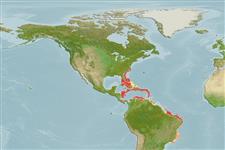Common names from other countries
Environment: milieu / climate zone / depth range / distribution range
Ecologie
; diepteverspreiding 1 - 300 m (Ref. 122059). Tropical; 35°N - 24°S, 83°W - 30°W (Ref. 4)
Western Atlantic and Indo-Pacific.
Length at first maturity / Size / Gewicht / Leeftijd
Maturity: Lm ? range ? - ? cm Max length : 15.0 cm TL mannelijk/geslacht niet bekend; (Ref. 4); common length : 10.0 cm TL mannelijk/geslacht niet bekend; (Ref. 4)
It has a maximum total body length of 15 cm, usually up to 10 cm (Ref. 4). Sublittoral to deep (Ref. 77016). Occurs at depths from 1 to 300 m, usually between 50 and 100 m and inhabits the outer parts of coral reef slopes (Ref. 4).
Life cycle and mating behavior
Geslachtsrijpheid | Voortplanting | Kuitschieten | Eieren | Fecundity | Larven
Members of the order Decapoda are mostly gonochoric. Mating behavior: Precopulatory courtship ritual is common (through olfactory and tactile cues); usually indirect sperm transfer.
Holthuis, L.B. 1991. (Ref. 4)
Status op de Rode Lijst van het IUCN (Ref. 130435)
Status bij CITES (Ref. 108899)
Not Evaluated
Not Evaluated
Gebruik door de mens
Visserij: van potentieel belang
| FishSource |
Tools
Meer informatie
Leeftijd/Grootte
Groei
Lengte-gewicht parameters
Lengte-lengte parameters
Morfologie
Larven
Abundantie
Internet-bronnen
Estimates based on models
Preferred temperature
(Ref.
115969): 18.2 - 27.4, mean 24.7 (based on 105 cells).
Kwetsbaarheid
Low vulnerability (10 of 100).
